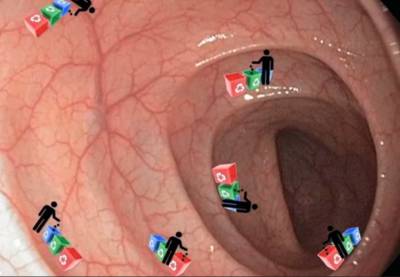DrCarney.com Blog
Lower Your Cholesterol Using Fiber!
If you're tired of all the side effects from taking statins to reduce your cholesterol, you may be interested in trying another approach that's safe, side-effect free, and shown to reduce cholesterol more than statins. What does this new approach involve? Eating! Eating a wide variety of whole, delicious, colorful, plant foods packed with micro-nutrients and fiber that offers powerful protection against disease. Dr. Michael Greger's video below explains how eating a low-fiber diet keeps excess cholesterol from being eliminated from the body while a high-fiber diet removes excess cholesterol.
How Does Eating a Fiber-Rich Diet Lower Cholesterol?
The word "fiber" may bring many thoughts to our minds. Helping us "stay regular" would be the most prominent thought for most of us. This is certainly true; however, fiber plays a much larger role in the prevention and reversal of disease. Removing excess cholesterol from our bodies is one of the many ways it prevents and reverses disease. Although cholesterol is a vital component in order for our body to work properly, the cells of our body and liver produce sufficient amounts of cholesterol to meet our daily needs without having to consume any cholesterol from our diets.
The human body was designed so that the digestive tract works optimally when an abundance of fiber-rich foods are present. So when the liver determines that there's too much cholesterol circulating in the bloodstream, it discards it into the intestinal tract, knowing that the fiber in the bowel will quickly escort it out of the body. It's important to note that a whole-food, plant-based diet can supply nearly 100+ grams of fiber a day, whereas a diet based on animal products and processed foods provides a distressing 10-15 grams per day.
The process by which fiber removes cholesterol begins with the enterocytes, cells lining the walls of the intestine. These cells act as "trash pickers" and "resource recovery workers" by sifting through the contents of the intestines, picking up anything that is potentially useful like vitamins/minerals. When fiber-rich foods are not present, the volume of digested food and speed in which it travels is significantly reduced. However, the number of "trash pickers" has not decreased. So when a fiber-deficient diet is eaten, the "trash pickers" have more time to hunt through and pick up elements in the waste that normally would have been eliminated with a fiber-rich diet. As a result, these cells are picking back up estrogen and many other toxins, along with cholesterol and recirculating it right back into the bloodstream. This "recirculation" helps keep hormone and cholesterol levels high. Click here to watch Dr. Neal Barnard's video clip on how this process works.
Because a diet high in fiber lowers hormone levels, it helps prevent cancers of the prostate, breast and ovary which are hormone-sensitive cancers. Sadly, nearly 90% of calories in the typical American diet come from meat, dairy, eggs, refined grains, oils, butter, shortening, candy, sodas, and potato chips, which are void of any fiber. This is the reason why 97% of people are deficient in this vital nutrient.
Benefits of Using a Dietary Approach
Having high cholesterol levels (hypercholesterolemia) is one risk factor in developing coronary heart disease. Theliver produces more cholesterol when consuming a diet high in saturated and trans fats (meat, dairy, eggs, processed foods). Because the pharmaceutal industry has created a "pill for every ill," many patients prefer to take a pill to treat their condition. While drugs offers symptomatic relief from the disease, it doesn't treat the cause of the disease. Seeing lower numbers gives the patient a false sense of security. Yet in reality, their disease continues to progress. See our Managing the Symptoms vs Treating the Illness and Die Sooner With Good Looking Numbers articles for more details.
Unlike statins, there are no unfavorable side effects or potential risks when using a dietary approach to lower cholesterol. Dr. John McDougall's starch-centered diet rich in whole plant food reduces cholesterol by 20% to 45% with strict adherence- which is more than statins. It must be noted though, that making moderate changes does not lead to dramatic health achievements and reversal of disease. A patient can't expect to see major cardiac beneifts by making minor changes to their diet. The benefits received by using a nutritional approach are directly proportional to the changes that are made. Making only small changes, while continuing to eat injurious foods will not offer any significant protection.
The protective role of whole natural plant foods against developing heart disease is well supported in the scientific literature. Heart disease is almost entirely preventable. We can make ourselves virtually heart attack proof by centering our diets on whole grains, beans/legumes, vegetables and fruits with a small addition of nuts/seeds.
For additional information, click on the following links:
(1) Eating Beans Lowers Cholesterol
(2) Statin Drugs and Cholesterol Reduction
(3) Starch-Smart® Diet Lowers Cholesterol
(4) Desirable Cholesterol Numbers
(5) What's the Daily Required Intake for Cholesterol?
(6) McDougall Moments on Cholesterol
(8) Die Sooner With Good Looking Numbers
(9) Linda Carney MD Heart Disease Pinterest Board
Michael Greger MD Links
Scroll Down Page to Leave Comments

Got Questions?
We would love to receive your questions. Join in the Starch-Smart Discussions on DrCarney.com by signing up for a free membership to the Dr. Carney Community.
When you subscribe to the blog, we will send you an e-mail when there are new updates on the site so you wouldn't miss them.




